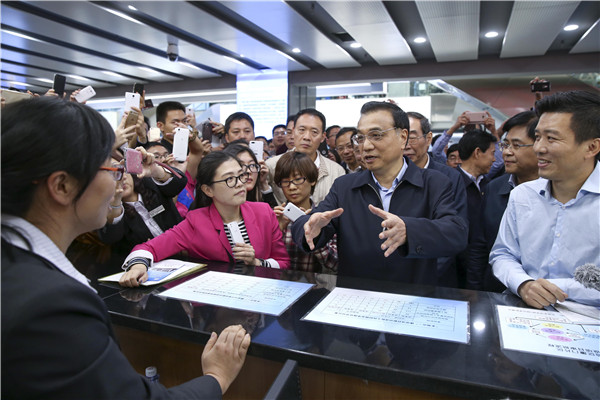
Premier Li Keqiang visits a service center in Xiamen, part of the Fujian Pilot Free Trade Zone (FTZ), on April 22, 2015, in a show of support and encouragement for the zone’s development. [Photo/Xinhua]
China will reinforce existing policies and streamline administrative procedures to promote a steady growth of imports and exports, the government announced on August 16.
The State Council meeting, chaired by Premier Li Keqiang, focused on key problems concerning trade policy implementation and measures needed to have them addressed.
During the meeting, while acknowledging that the economy had recorded an outstanding performance in the first half of the year, Premier Li pointed out that a sluggish global outlook and weak overseas demand had undermined efforts to shore up China’s trade volume. Rising domestic manufacturing costs have also had consequences for China’s imports and exports.
A series of policies have been released by the Chinese government since 2013 to encourage the steady growth of foreign trade, and in recent years, China has remained the world’s largest trading nation in terms of goods.
Yet, due to the impacts of the world financial crisis, as well as faltering global growth, China’s foreign trade growth started to lose momentum.
“We should enhance steady growth both in exports and imports to advance country’s industrial upgrading to attract new foreign investment on top of the foreign investment already in the Chinese market,” Premier Li stressed.
“An increase in this year’s imports could bring higher exports next year,” he said.
An evaluation was completed recently on the implementation of the policies to see how well they had boosted China’s foreign trade. The evaluation was mainly overseen by the Ministry of Commerce, China’s National Development and Reform Commission and the Ministry of Finance.
It was revealed that while existing measures have contributed substantially to promoting China’s trade growth via financial support measures such as tax reduction and encouraging new types of trade such as e-commerce, there were still certain problems.
High financing costs for companies remain a major burden in maintaining trade growth. Other problems include sluggish trade policy implementation and outdated management methods.
A third party evaluation was conducted by the State Council’s Development Research Center (DRC) in July, through field research in enterprises in nine cities. The evaluation report shows China’s trade faces the combined headwind of the global economy’s in-depth adjustment and China’s economic transition.
Besides problems such as high financing costs for enterprises, the DRC evaluation reveals some other problems affecting trade growth. For example, officials are not aware enough about problems encountered during policy implementation. Also, while domestic labor costs kept rising, the country has not established competence based on technology, branding and marketing in the global market. In some areas, existing policies need to be updated for more variety among foreign trade businesses.
China customs figures show that in the first half of 2016, China’s foreign trade was valued at 11.13 trillion yuan ($1.7 trillion), a drop of 3.3 percent year-on-year, while exports amounted to 6.4 trillion yuan, down 2.1 percent. The value of imports decreased by 4.7 percent to 4.73 trillion yuan, but the country’s trade surplus increased by 5.9 percent to 1.67 trillion yuan.
Premier Li highlighted the importance of further opening up various sectors to market competition. He also required related government departments to enhance efforts in providing greater efficiency in facilitating customs clearance and financing channels.
More measures will be introduced for ensuring a steady growth of China’s foreign trade after the meeting:
--- First, detailed adjustments will be made on existing polices to better facilitate foreign trade development and better streamline procedures in trade gateways.
--- Second, finance institutions are encouraged to provide more financial and credit support to enterprises with substantial business profits, and export credit insurance will cover a wider range.
--- Third, procedures for tax reimbursement of exports will be more efficient, and unnecessary harbor and shipping costs will be reduced, creating a fair market for competition.
---Four, policies will be further adjusted to facilitate new types of trade, such as cross-border e-commerce.
--- Five, the role for bilateral investment will be further encouraged to boost foreign trade, through promoting the country’s Belt and Road Initiative, as well as international cooperation on capacity.
“China is now deeply integrated with the world economy, and our international competitiveness will be better enhanced through opening up,” Premier Li stressed. “China has opened its door to the world. The door will never be closed again, and will be opened even further.”
